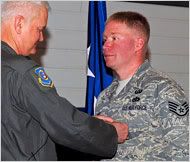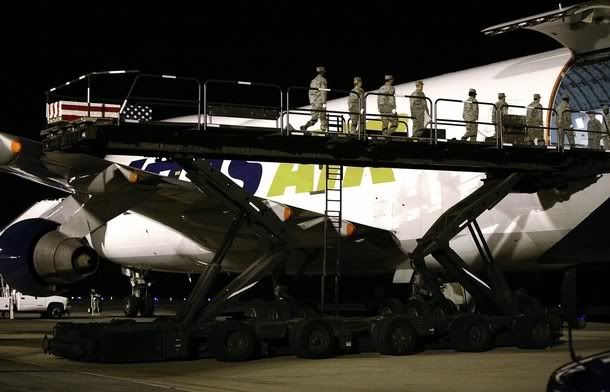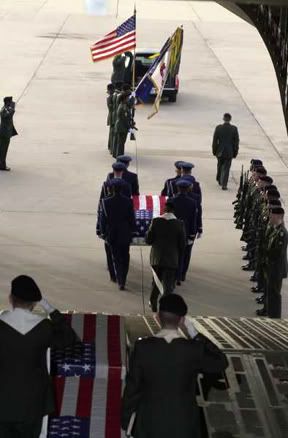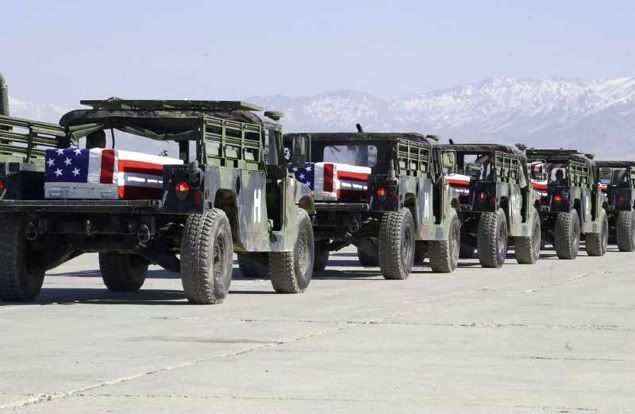( – promoted by buhdydharma )
You do not need to know his name to understand the enormity of what he is a part of, yet it is important that you do. You do not need to know that he died in Afghanistan, yet that point is not incidental to the existence of the flag-draped box left on the platform.
The coffin of Staff Sergeant Phillip Myers sits on the plane gangway at Dover Air Force Base in Dover, Delaware.
SSgt. Myers’ family gave permission for publication of this photo and it is the first published under the removal of the ban on photographs of coffins of soldiers killed in Iraq and Afghanistan as they arrive at Dover Airforce Base.
For analysis of the photos and further discussion, see BAGnewsNotes.
That permission is not insignificant as without it, under Obama’s change in policy, we would not see this photo at all. I don’t know that the photo is any more or less significant in the big picture without that information. It seems to function as an intentional admission on the part of our government:
Here lies SSgt. Phillip Myers of Hopewell, Virginia, son, brother, father, kid next door, airman, recent Bronze Star recipient, killed in service to our country in Afghanistan. This is just the beginning. We will see more.
But knowing the name involves us all in his family’s grief and knowledge of this young man.

SSgt. Myers receiving the Bronze Star in 2008 for service in Iraq.
As Michael Shaw notes at BAGnews, the fact that SSgt. Myers was killed in action in Afghanistan is significant as Iraq winds down. The military personnel who die in Iraq are no less important, but in our collective thought, Iraq is winding down; Afghanistan may just be beginning again.
Obama conditionally lifted the twenty year ban on such photographs soon after taking office. The original ban, imposed by George H.W. Bush in 1989 (according to the link below, but I believe it was during the first Gulf War rather than the Panama invasion), due to his embarrassment at seeing the coffins at Dover, was tightened and increased by George W. Bush’s administration in 2005.
…when Defense Department lawyers realized they couldn’t keep those government images from becoming public, the military ordered an end to its own photography.
Ralph Begleiter was CNN’s world-affairs correspondent from 1981-1999 and writes of these photos in The Daily Beast:
More than 700 photos had been forced into public view by my Freedom of Information lawsuit together with the National Security Archive at George Washington University. To my knowledge, the media ban-combined with the halt to government photography-has forever hidden images the thousands of troops who passed through Dover on their way to burial from mid-2005 until today.
Begleiter notes
News organizations-especially television-have discovered that Americans don’t want to watch the war in progress. Newscast ratings actually decline when reports from Iraq and Afghanistan appear on television.
We don’t want to look, apparently. But we should. And we should know his name. We need to know it.
Below are some of the photos released by the government due to Begleiter’s FOIA lawsuit and published in Begleiter’s article. These soldiers, sailors, air men, marines and the conflict in which they died remain unidentified. Perhaps that information is not important. But I would like to know those names and think we all should know them to know that they are not just boxes draped in a flag but sons, daughters, fathers, mothers, the kid next door, an interruption in our news consumption, unwelcome and hard to look at. But necessary as we send more men and women to Afghanistan and Iraq.
Update: Various sources identify 1991 as the year in which the ban was put into effect, however, Beglieter wrote that the ban occurred in 1989, the year in which we invaded Panama. Elizabeth Bumiller explains in the New York Times:
The original 1991 ban had its genesis in an embarrassment for the first President Bush.
In 1989, the television networks showed split-screen images of Mr. Bush sparring and joking with reporters on one side and a military honor guard unloading coffins from a military action that he had ordered in Panama on the other.
Mr. Bush, a World War II veteran, was caught unaware and subsequently asked the networks to warn the White House when they planned to use split screens. The networks declined.
At the next opportunity, in February 1991 during the Persian Gulf war, the Pentagon banned photos of returning coffins.
Note: Originally posted in the wee hours of the morning on Daily Kos.





5 comments
Skip to comment form
I grew up here
I was indoctrinated into American cultural norms
I was a Boy Scout, a pilot, an engineer, a father
I saluted the flag and celebrated Fourth of July
I ran for public office to participate in the greater community
BUT
I had an expat assignment which did two things
It removed me from my “culture”
It showed me another “culture”
It gave me the tools to realize “our” real history.
we should have seen the names and faces of every one of the dead who came home. The Iraq war dead gave their lives for the oil barons – and a dumb oil scion son’s idea of revenge. What a God-awful waste of human lives.